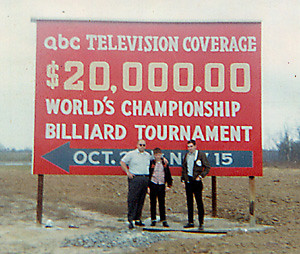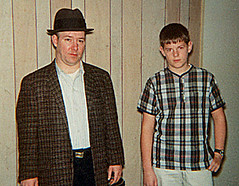I an older player, and I have been away from pool for a very long time. How can I improve my game after such a long lay-off? I'd like to get back up to speed, but I don't even know where to begin! With your mysterious arcane abilities, I know you can help me.
Signed,
Rufus from Texas
Funny you should ask, Rufus. As it turns out, the very same question has been posed for the 21st edition of the PoolSynergy project, the online collaborative effort in which pool bloggers write about a single topic. As a fond reader of PoolSynergy and a devout practitioner of the arcane arts, I, La Voyante the Mysterious, have bent my entire will to answering this very excellent question.
| Joe "The Meatman" Balsis |
Why is Joe Balsis, the one they call "The Meatman," the key to your question? It is simply this: Mr. Balsis was a national champion as a young boy, abandoned the game shortly after World War II, but then came back 17 years later to become champion again. Historians tell La Voyante that Mr. Balsis holds the American record for the longest layoff in championship pool.
La Voyante is a great man, but also a humble one, and so he turns to the expertise of George Fels, the Billiards Digest columnist, for more information about the one they call The Meatman. La Voyante has learned from reading Mr. Fels' expert columns that The Meatman was the son of a poolroom owner from Minersville, Pennsylvania, won the Philadelphia City Boys Championship in 1932 at age 11, and then went on to win four consecutive National Junior Pocket Billiard Titles. So famous was young Joe Balsis that his picture appeared in The New York Times, right next to fellow pool stars Ralph Greenleaf and Willie Hoppe.
| George Fels |
| Another of La Voyante's Favorite Books |
In 1966 Joe Balsis placed second to Irving Crane in the Billiard Congress of America’s inaugural straight pool U.S. Open in Chicago, won the Johnston City all-around, and took out Willie Mosconi during a high-profile competition in California as Mosconi was attempting his own return to pool. Mr. Balsis during this California event beat Mr. Mosconi in the finals and also pocketed an average of 22 balls per inning during the tournament, shattering an old record held by Mosconi. (You can read more about this tournament and about the prickly Mr. Mosconi in The Hustler & The Champ, another of La Voyante's favorite books.)
| La Voyante's Pool Instructional Device |
Mr. Balsis was inducted into the Billiard Congress Hall of Fame in 1982.
So, Rufus, back to your question: How should one train after a long lay-off from the sport? Only Joe Balsis can know for sure. After all, no man, dead or alive, has made such a come back as The Meatman. For your answer, La Voyante shall continue to consult his Ouija board. When La Voyante hears from the great beyond, so shall you!
About PoolSynergy
PoolSynergy is an online collaborative effort by pool and billiard bloggers, in which each agrees to write about a single theme. To read a list of the other fine contributions this month, check out PoolBum's excellent blog, which you can find here. If you have a question for La Voyante or a suggested topic for the PoolSynergy project, please send it to R.A. Dyer, care of this email address.




















